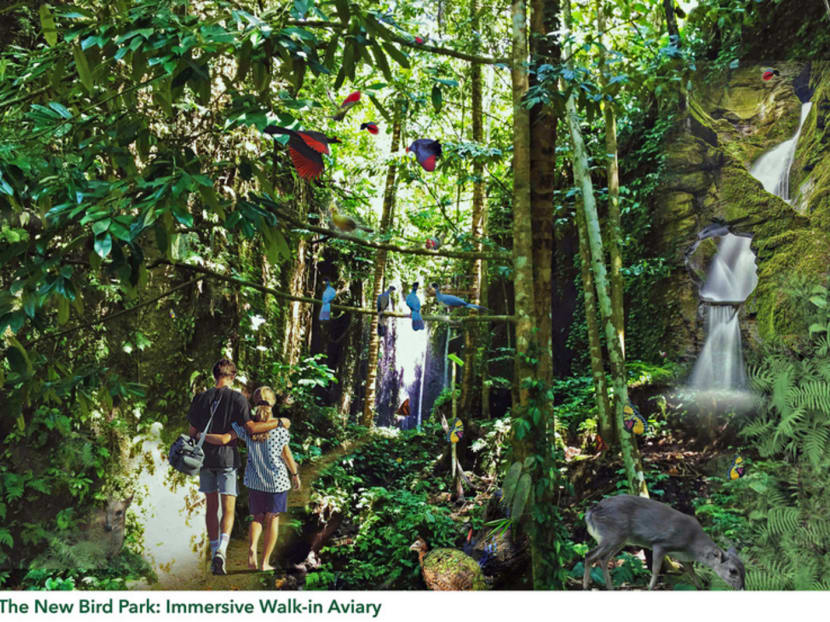Impact on existing wildlife, plants among concerns over Mandai project
SINGAPORE — The potential impact on wildlife in Mandai as well as the type of “green mitigation” measures needed to protect the natural habitats in the area are among the issues being ironed out ahead of a pending Environmental Impact Assessment (EIA) report on the planned mega-project.

An artist’s impression of the new bird park. There are concerns about the eco-friendliness of the new bird park, which would require more fences and pose problems for wildlife movement in the area. Photo: Mandai Safari Park Holdings
SINGAPORE — The potential impact on wildlife in Mandai as well as the type of “green mitigation” measures needed to protect the natural habitats in the area are among the issues being ironed out ahead of a pending Environmental Impact Assessment (EIA) report on the planned mega-project.
The report, said Mandai Safari Park Holdings (MSPH) yesterday, will be out “in a few weeks”.
In the meantime, it is in discussions with government agencies and various nature groups on environmental issues that could arise from plans such as introducing a large collection of birds into the area with a new bird park, and building a new eco-bridge for wildlife to roam.
Commenting on the plans, which were announced yesterday, Dr Ho Hua Chew, vice-chair of Nature Society’s (Singapore) conservation committee, said he was concerned about the eco-friendliness of the new bird park and possible adverse impact on local wildlife in the area. The planned bird park, which MSPH had touted as one of the world’s largest collection of birds, would require more fences and pose problems for wildlife movement, he said, describing it as an “artificial, completely non-wild set-up”.
“There will be problems of escapees into our nature reserve; there can be no absolute control. (It could also be a) possible source of infections to our local birdlife,” added Dr Ho, who has been in talks with MSPH since redevelopment plans were first revealed.
While he felt heartened by plans for an eco-bridge, he noted that the site proposed is too narrow and crosses over the nature reserve at an “awkward spot” on the side of Mandai Lake Road. Suggesting an alternative location in a central part of the land further away from the road for the bridge, Dr Ho said this would encroach into land earmarked for the planned bird park, but such an important ecological benefit and value should not be sacrificed.
Dr Ho also pointed out that the land set aside for the planned Rainforest Park has been left alone for decades, turning into secondary forest and becoming home to wildlife like the leopard cat, Sunda pangolin and grey-headed fish eagle. “More local plant species can be slowly introduced but there should not be any clear-felling of large tracts of trees,” he said.
Professor Peter Ng of the Lee Kong Chian Natural History Museum, which is conducting the EIA with MPSH and National University of Singapore under the guidance of the National Parks Board, said he could not elaborate on the issues under discussion at this point in time.
But he stressed that progress has been made in the talks, which include non-governmental agencies like Animal Concerns Research & Education Society (ACRES), Nature Society (Singapore) and Nature Trekker, and wildlife experts like Mr Joseph Koh, an authority on spiders.
Mr Koh did not respond by press time, while ACRES and Nature Trekker could not comment.
Asked about previous calls by the nature groups for a buffer zone to be created between man-made and existing forested areas, Prof Ng said that it is not an easy balance, and added that discussions on how to make the planned eco-bridge effectively are ongoing. He also said the land set aside for the planned Rainforest Park, which will involve reforestation efforts, has already seen development over the areas, but important plants and habitats within the area must be protected.
“The Mandai develop(ers) are fully aware of this and are now juggling their own plans to accommodate. … The agencies and NGOs have been pointing out what are necessary “green mitigations” that need to be done, and they are being factored in as far as possible,” said Prof Ng.
“The plan is evolving continuously so that as many concerns as possible can be addressed.”









